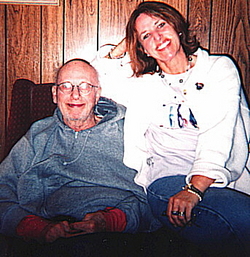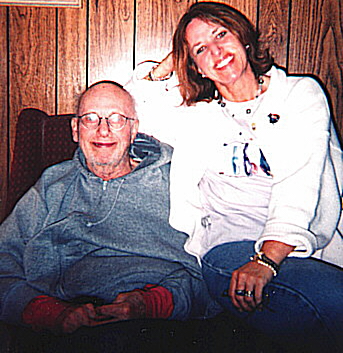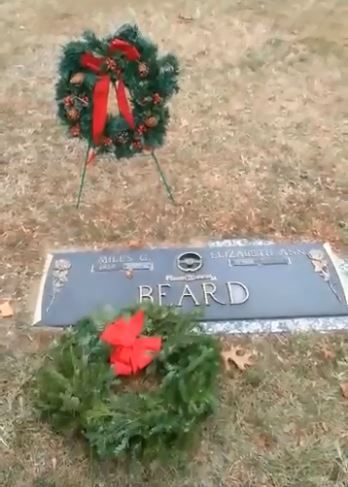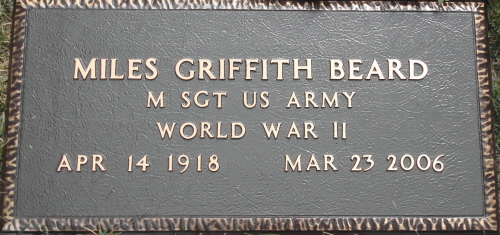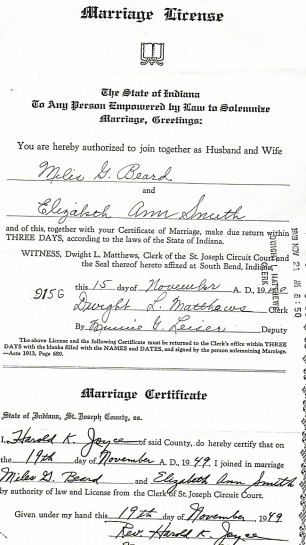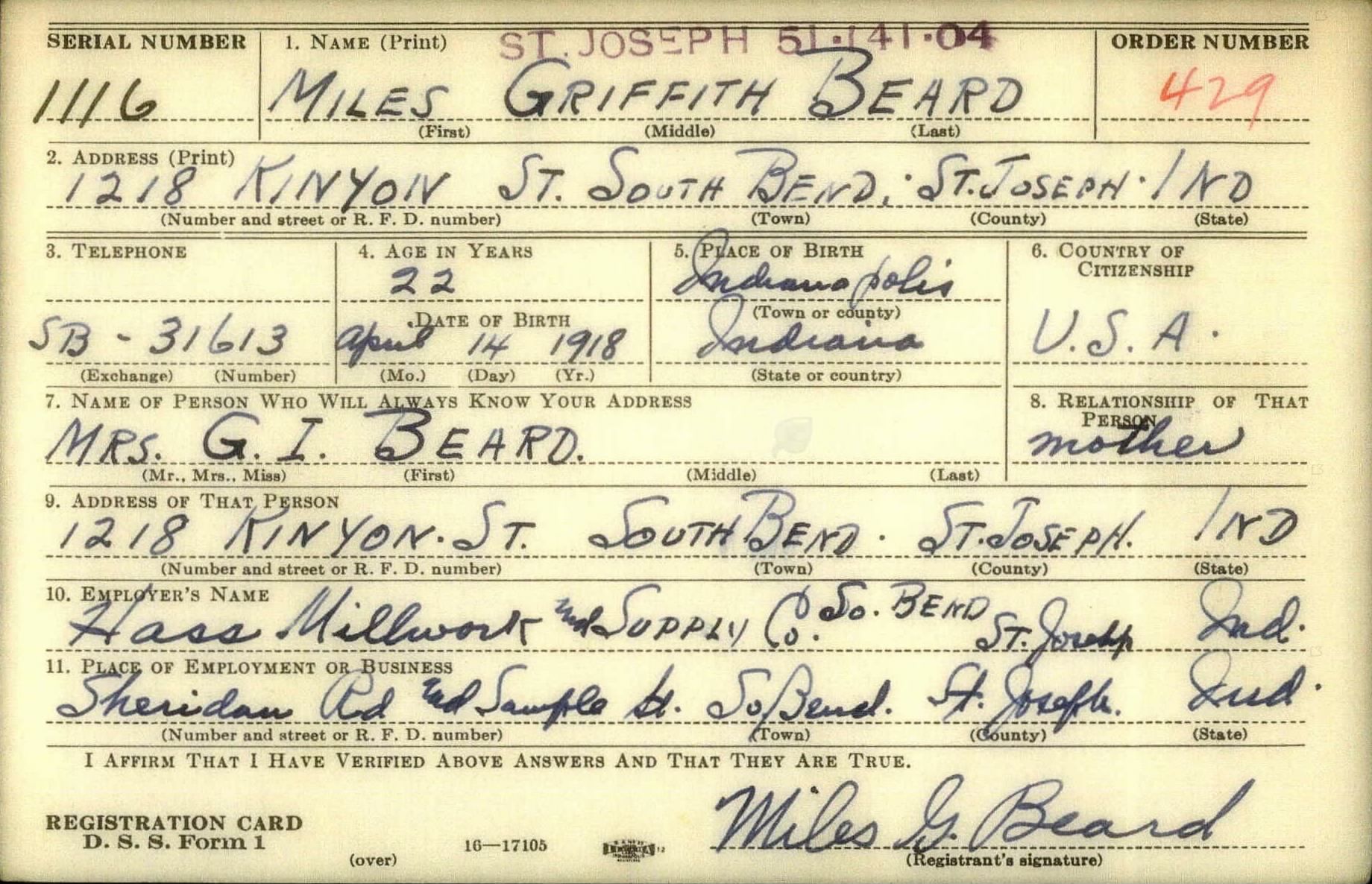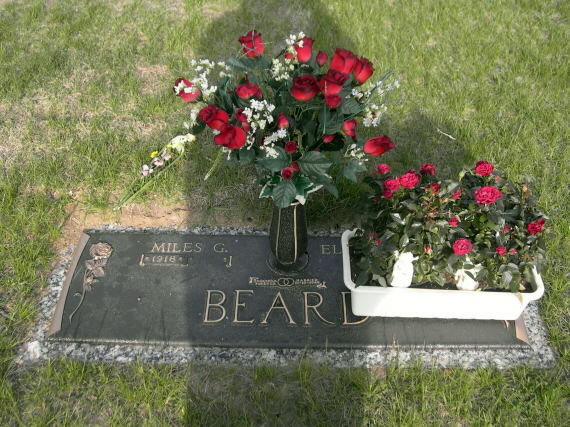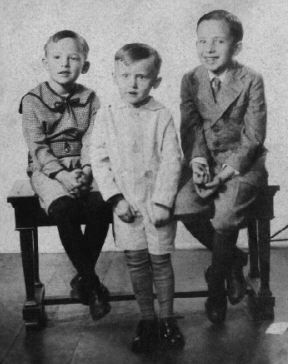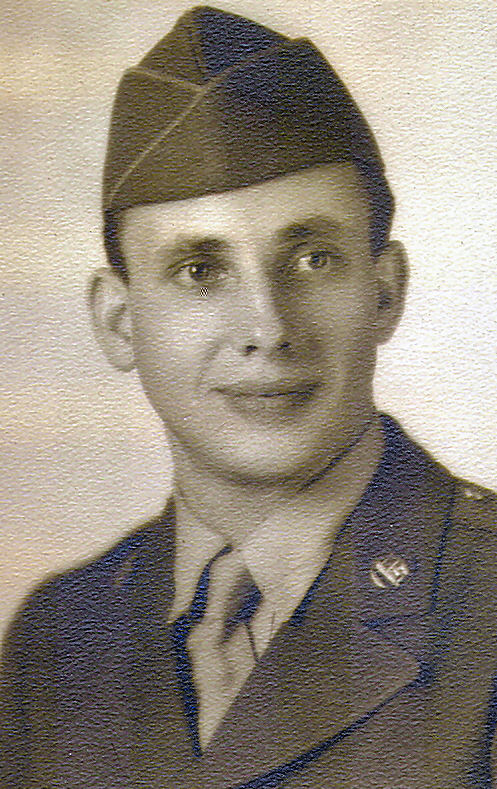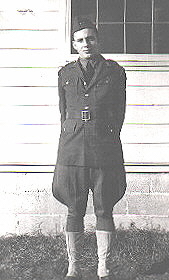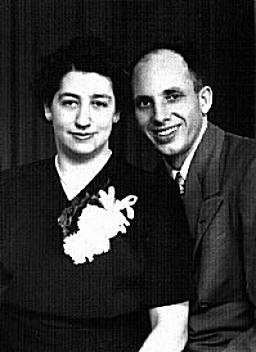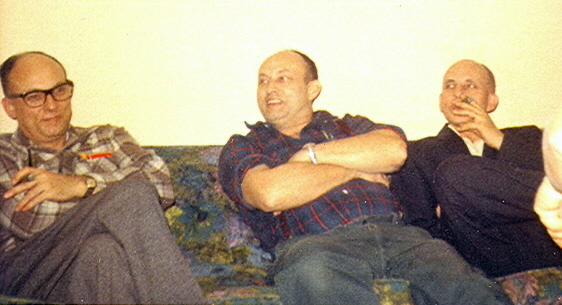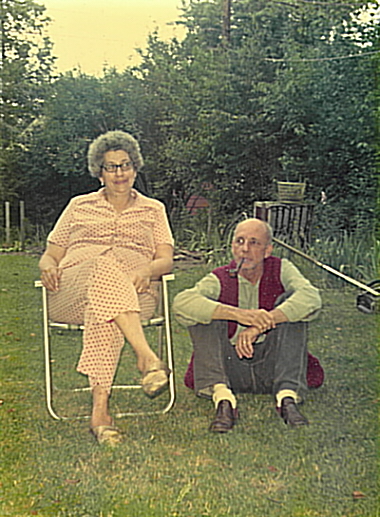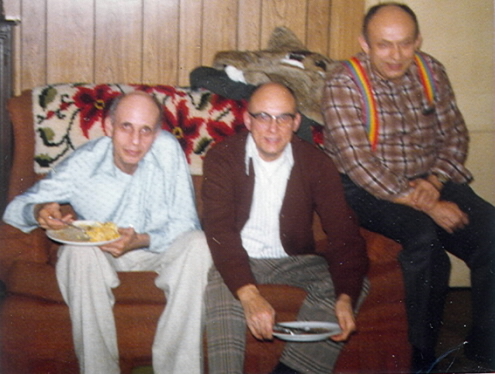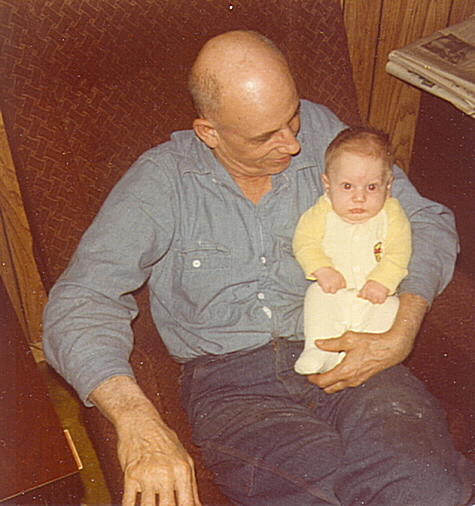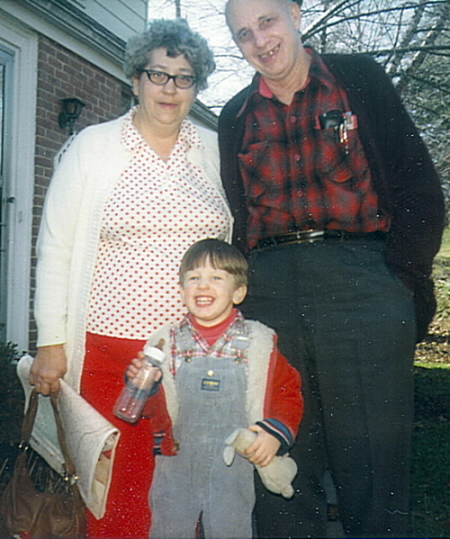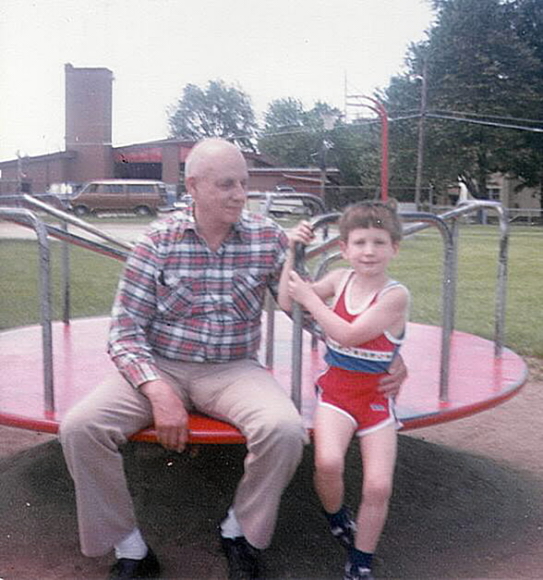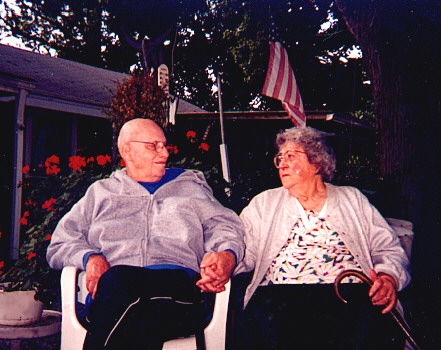Co. E, 113th Engineer (Combat) Battalion
Miles G. Beard survived the Great Depression as a teenager in northern Indiana, spent World War II in the U.S. Army, and returned home to spend the rest of his working years laboring in a factory. His pleasures were stamp collecting, fishing, gardening, and having a good beer.
Miles' father was 20 years old when Miles was born. His dad spent the first year of Miles' life working on Miles' grandfather's farm in Owasco, Indiana. Then Miles' dad rented land in Fulton County and farmed; then he farmed in LaGrange County. Before Miles was ten years old, his father had moved the family to South Bend where he first worked at Studebaker's. Miles and his younger brothers, Max and Bruce, grew up in South Bend, in a little house on Kinyon Street, near the St. Joseph River. When the house sold to Miles' parents, the biggest selling point was that it had a bathtub, something not all houses had in those days. Why did that house have a bathtub? Because it had been used by a moonshiner during days of Prohibition.
Miles graduated from South Bend Central High School in 1936 and studied at University of Chicago before joining the U.S. Army in 1940. He served in the U.S. military from December 23, 1940, until December 27, 1945, five years and four days. Co. E, 113th Engineer (Combat) Battalion. He served in the United States and in the Philippines. He was honorably discharged as a Master Sergeant. He was awarded a Good Conduct Medal, an American Theater Ribbon with two Bronze Stars, an Asiatic Pacific Theater Ribbon, a Victory Medal, and a Philippine Liberation Ribbon.
On November 19, 1949, in South Bend, he married Elizabeth Ann Smith née Doyle, a divorcée with two children from her previous marriage. Almost from the start, Miles took on the financial support of the two step-children because their father rarely came thru with the meager court-ordered support check.
Ten months after Miles married Elizabeth Ann, his first child was born, a daughter. Five years later, a son. Two more sons followed. The family lived in the Normain Heights neighborhood of Mishawaka, Indiana. It was a neighborhood built for returning WW II servicemen. Miles' house was a one-floor house, built on a slab: living room, kitchen, 3 bedrooms, one bathroom, and a utility room -- where Miles has lots of tools. The yard was big enough for children to play in, and children ran thru the neighborhood and played in the streets.
In Normain Heights, among Miles' closest neighbors for many years were Betty Casper, Joe and Pat Callahan, John and Lois Takach, and Clarence and Marguerite Cox.
Miles worked at UniRoyal (BallBand) for 30 years before retiring. He was a member of United Rubber Workers Local Union #65. He operated a rubber vulcanizer, making rubber mats for cars and trucks. He and co-worker Ed Costa made the specialty mats.
For many years Miles was a member of the Northern Indiana Philatelic Society, a social group for stamp collectors.
Miles had a massive stroke in March 1999 and received no medical attention for more than three hours. He was intentionally left without care for three hours. The stroke left him with serious brain damage, greatly diminished mental capacity, and partial paralysis on his right side. Left with diminished executory function, the octogenarian World War II veteran was manipulated by some after the massive stroke, manipulated in ways that were to his disadvantage. After being hospitalized in late 2004, he was moved to Mishawaka's Fountainview Nursing Home where he lived for the last 14-and-a-half months of his life.
At Fountainview, his roommate was Bernard Lenczowski. Two of the men he ate his meals with -- three times a day for seven months -- were Tom Loughlin and John Thornburg. Miles, Tom, John, and one other man always sat together for meals, at a four-person table, next to a window that overlooked an open grassy area where geese wandered. In the last month of Miles' life, a new man joined the table group, Philip Hess. One of the friendly faces at Fountainview was Carol Geist; Carol would visit Miles and cheer him up. For the last 14 months of Miles' life, the people at Fountainview were Miles' "family."
Miles' wife survived him, dying December 8, 2007.
From late October 2006 until soon after July 30, 2007, Miles' burial site was marked with a military marker. It was a marker provided by the Veterans Administration, a bronze plaque on a granite base. The marker read
MILES GRIFFITH BEARD
M SGT US ARMY
WORLD WAR II
APR 14 1918 . MAR 23 2006
The military marker was ordered removed by the person who had used Miles' money to arrange for advance payment of Miles' grave site. After Miles' massive stroke in 1999 that left him brain damaged, the person gained power of attorney and control over Miles' meager financial assets. In the end, the person ordered his death by forced dehydration, and, months after his death, the person ordered the removal of Miles' military marker from his grave site. Complicit with that person were two attorneys, both who were later disbarred for dishonesty, and one who (as of 2019) is serving time in prison for convictions related to dishonesty and theft.
Miles' philosophy of life was that "God says the choice is yours, and yours alone. But if you make the wrong choice, suffer, buddy, suffer." Miles suffered for his wrong choices.
Another of Miles' memorable statements regarded the saying, "There are no sadder words than 'what might have been.'" To that, Miles said, "Yes, there are sadder words: What was and should not have been."
One conversation remembered by his daughter tells lots about Miles:
When she was a teenager, his daughter asked him, "Dad, do you believe that the Virgin Mary conceived without sex, and that she was a virgin still when Jesus was born?"
Miles had a long, thoughtful pause before replying: "I don't know. But if YOU ever come home that way, Alice, you'd better have a better excuse."
Did Miles believe in God? That exchange surely would suggest so. He apparently had some doubts about some Church teachings, but his doubt was not about the truth of God.
Five years after Miles died, in April 2011, his daughter chanced to be in contact with a nurse from Fountainview, the nursing home where Miles lived his last 15 months. The nurse's words: "I remember your dad with the fondest memories. He loved his beer. … Just know your dad touched many hearts. We still talk of him from time to time. He was a good man and charming as heck."
Among the happy things to remember of his life are these:
(1) Before Miles was two years old, instead of a pony, he rode a pig named Pollyanna. The pig was his dad's prize brood sow.
(2) When Miles was a kid, he ate geranium leaf sandwiches made by his neighbor Mrs. Emma Marsac.
(3) In the "Class Will" for the Central High School 1936 yearbook is this: "We, MARY LOU MARTIN and MILES BEARD, bequeath our prize-winning abilities in University of Chicago exams to various oncoming brilliant intellects." Miles won a one-year merit scholarship to the University of Chicago.
(4) Like all training sergeants, Miles took his turn leading morning exercises. Miles was not a "morning person." On his mornings, he would hold up his hand, stick out a finger, bend his finger up and down, and call out, "One-two-three-four." And that was his morning exercise for the troops.
(5) When Miles had young children, he paid ten cents a bag for every bag of chickweed that a child pulled from his garden.
(6) He was an excellent math tutor. Because of his genes and his tutoring, all four of Miles' children excelled at math.
Miles was survived by his wife, his daughter Alice, his sons Jes and Rex, and perhaps his son Dale (who had not been heard from for many years). Miles also was survived by two grandsons, four granddaughters, and perhaps by a rumored grandson for whom there is no proof. (According to a story Miles' wife told his daughter in August 2001, Miles' first-born grandchild was a grandson born in 1975. It is not known whether Miles ever was told the story; it is not known whether the story was true; and -- assuming the story was true -- it is not known whether the grandson lived beyond January 1978.)
Autosomal DNA testing on Miles's only known daughter and on a son of Miles' paternal 1st cousin matched (with a match greater than 215 centimorgans). Then, Y-DNA testing on that 1st cousin's son determined Miles' Y-DNA sequence to 67 markers. Information is on the findagrave page for Miles' two-greats-grandfather John Beard. (NOTE: Miles' daughter also DNA-matched with the daughter of another of Miles' paternal 1st cousins, also with a match greater than 215 centimorgans.)
Miles Beard's Y-DNA sequence (tested at familyTreeDNA):
DYS393 is 12.
DYS390 is 23.
DYS19 is 14.
DYS391 is 10.
DYS385 is 15-17.
DYS426 is 11.
DYS388 is 12.
DYS439 is 11.
DYS389i is 13.
DYS392 is 15.
DYS389ii is 28.
Haplogroup L, further classified as L-M20.
NOTE: Page created by Miles' only daughter.
..............
..............
Fifteen years after my dad's death, I'm able to write these words. They are blunt, but polite. I write them with the hope that they survive, that some truth is preserved:
My dad's end was hard. He had a massive stroke in March 1999 and received no medical attention for more than three hours. He was intentionally and knowingly left lying on the floor, where he had fallen, in his own home. The stroke left him with serious brain damage, greatly diminished mental capacity, and partial paralysis on his right side. Left with diminished executive function, the octogenarian World War II veteran was manipulated by some people after the massive stroke, manipulated in ways that were to his disadvantage.
He died in March 2006. By late October 2006, there was a military marker placed on his grave.
The military marker was ordered removed by the person who had used my dad's money to arrange for advance payment of his grave site. After the massive stroke in 1999 that left him brain damaged, the person gained power of attorney and control over my dad's meager financial assets. In the end, the person ordered his death by forced dehydration, and, months after his death, the person ordered the removal of the military marker from his grave site.
Complicit with that person were two attorneys, both who were later disbarred for dishonesty, and one who is serving time in prison for convictions related to dishonesty and theft.
And, yes, as shocking and horrifying as that all sounds, every word is true. I write these words so that his grandchildren may know the truth, and so that -- if ever there are any great-grandchildren -- they may know the truth.
Co. E, 113th Engineer (Combat) Battalion
Miles G. Beard survived the Great Depression as a teenager in northern Indiana, spent World War II in the U.S. Army, and returned home to spend the rest of his working years laboring in a factory. His pleasures were stamp collecting, fishing, gardening, and having a good beer.
Miles' father was 20 years old when Miles was born. His dad spent the first year of Miles' life working on Miles' grandfather's farm in Owasco, Indiana. Then Miles' dad rented land in Fulton County and farmed; then he farmed in LaGrange County. Before Miles was ten years old, his father had moved the family to South Bend where he first worked at Studebaker's. Miles and his younger brothers, Max and Bruce, grew up in South Bend, in a little house on Kinyon Street, near the St. Joseph River. When the house sold to Miles' parents, the biggest selling point was that it had a bathtub, something not all houses had in those days. Why did that house have a bathtub? Because it had been used by a moonshiner during days of Prohibition.
Miles graduated from South Bend Central High School in 1936 and studied at University of Chicago before joining the U.S. Army in 1940. He served in the U.S. military from December 23, 1940, until December 27, 1945, five years and four days. Co. E, 113th Engineer (Combat) Battalion. He served in the United States and in the Philippines. He was honorably discharged as a Master Sergeant. He was awarded a Good Conduct Medal, an American Theater Ribbon with two Bronze Stars, an Asiatic Pacific Theater Ribbon, a Victory Medal, and a Philippine Liberation Ribbon.
On November 19, 1949, in South Bend, he married Elizabeth Ann Smith née Doyle, a divorcée with two children from her previous marriage. Almost from the start, Miles took on the financial support of the two step-children because their father rarely came thru with the meager court-ordered support check.
Ten months after Miles married Elizabeth Ann, his first child was born, a daughter. Five years later, a son. Two more sons followed. The family lived in the Normain Heights neighborhood of Mishawaka, Indiana. It was a neighborhood built for returning WW II servicemen. Miles' house was a one-floor house, built on a slab: living room, kitchen, 3 bedrooms, one bathroom, and a utility room -- where Miles has lots of tools. The yard was big enough for children to play in, and children ran thru the neighborhood and played in the streets.
In Normain Heights, among Miles' closest neighbors for many years were Betty Casper, Joe and Pat Callahan, John and Lois Takach, and Clarence and Marguerite Cox.
Miles worked at UniRoyal (BallBand) for 30 years before retiring. He was a member of United Rubber Workers Local Union #65. He operated a rubber vulcanizer, making rubber mats for cars and trucks. He and co-worker Ed Costa made the specialty mats.
For many years Miles was a member of the Northern Indiana Philatelic Society, a social group for stamp collectors.
Miles had a massive stroke in March 1999 and received no medical attention for more than three hours. He was intentionally left without care for three hours. The stroke left him with serious brain damage, greatly diminished mental capacity, and partial paralysis on his right side. Left with diminished executory function, the octogenarian World War II veteran was manipulated by some after the massive stroke, manipulated in ways that were to his disadvantage. After being hospitalized in late 2004, he was moved to Mishawaka's Fountainview Nursing Home where he lived for the last 14-and-a-half months of his life.
At Fountainview, his roommate was Bernard Lenczowski. Two of the men he ate his meals with -- three times a day for seven months -- were Tom Loughlin and John Thornburg. Miles, Tom, John, and one other man always sat together for meals, at a four-person table, next to a window that overlooked an open grassy area where geese wandered. In the last month of Miles' life, a new man joined the table group, Philip Hess. One of the friendly faces at Fountainview was Carol Geist; Carol would visit Miles and cheer him up. For the last 14 months of Miles' life, the people at Fountainview were Miles' "family."
Miles' wife survived him, dying December 8, 2007.
From late October 2006 until soon after July 30, 2007, Miles' burial site was marked with a military marker. It was a marker provided by the Veterans Administration, a bronze plaque on a granite base. The marker read
MILES GRIFFITH BEARD
M SGT US ARMY
WORLD WAR II
APR 14 1918 . MAR 23 2006
The military marker was ordered removed by the person who had used Miles' money to arrange for advance payment of Miles' grave site. After Miles' massive stroke in 1999 that left him brain damaged, the person gained power of attorney and control over Miles' meager financial assets. In the end, the person ordered his death by forced dehydration, and, months after his death, the person ordered the removal of Miles' military marker from his grave site. Complicit with that person were two attorneys, both who were later disbarred for dishonesty, and one who (as of 2019) is serving time in prison for convictions related to dishonesty and theft.
Miles' philosophy of life was that "God says the choice is yours, and yours alone. But if you make the wrong choice, suffer, buddy, suffer." Miles suffered for his wrong choices.
Another of Miles' memorable statements regarded the saying, "There are no sadder words than 'what might have been.'" To that, Miles said, "Yes, there are sadder words: What was and should not have been."
One conversation remembered by his daughter tells lots about Miles:
When she was a teenager, his daughter asked him, "Dad, do you believe that the Virgin Mary conceived without sex, and that she was a virgin still when Jesus was born?"
Miles had a long, thoughtful pause before replying: "I don't know. But if YOU ever come home that way, Alice, you'd better have a better excuse."
Did Miles believe in God? That exchange surely would suggest so. He apparently had some doubts about some Church teachings, but his doubt was not about the truth of God.
Five years after Miles died, in April 2011, his daughter chanced to be in contact with a nurse from Fountainview, the nursing home where Miles lived his last 15 months. The nurse's words: "I remember your dad with the fondest memories. He loved his beer. … Just know your dad touched many hearts. We still talk of him from time to time. He was a good man and charming as heck."
Among the happy things to remember of his life are these:
(1) Before Miles was two years old, instead of a pony, he rode a pig named Pollyanna. The pig was his dad's prize brood sow.
(2) When Miles was a kid, he ate geranium leaf sandwiches made by his neighbor Mrs. Emma Marsac.
(3) In the "Class Will" for the Central High School 1936 yearbook is this: "We, MARY LOU MARTIN and MILES BEARD, bequeath our prize-winning abilities in University of Chicago exams to various oncoming brilliant intellects." Miles won a one-year merit scholarship to the University of Chicago.
(4) Like all training sergeants, Miles took his turn leading morning exercises. Miles was not a "morning person." On his mornings, he would hold up his hand, stick out a finger, bend his finger up and down, and call out, "One-two-three-four." And that was his morning exercise for the troops.
(5) When Miles had young children, he paid ten cents a bag for every bag of chickweed that a child pulled from his garden.
(6) He was an excellent math tutor. Because of his genes and his tutoring, all four of Miles' children excelled at math.
Miles was survived by his wife, his daughter Alice, his sons Jes and Rex, and perhaps his son Dale (who had not been heard from for many years). Miles also was survived by two grandsons, four granddaughters, and perhaps by a rumored grandson for whom there is no proof. (According to a story Miles' wife told his daughter in August 2001, Miles' first-born grandchild was a grandson born in 1975. It is not known whether Miles ever was told the story; it is not known whether the story was true; and -- assuming the story was true -- it is not known whether the grandson lived beyond January 1978.)
Autosomal DNA testing on Miles's only known daughter and on a son of Miles' paternal 1st cousin matched (with a match greater than 215 centimorgans). Then, Y-DNA testing on that 1st cousin's son determined Miles' Y-DNA sequence to 67 markers. Information is on the findagrave page for Miles' two-greats-grandfather John Beard. (NOTE: Miles' daughter also DNA-matched with the daughter of another of Miles' paternal 1st cousins, also with a match greater than 215 centimorgans.)
Miles Beard's Y-DNA sequence (tested at familyTreeDNA):
DYS393 is 12.
DYS390 is 23.
DYS19 is 14.
DYS391 is 10.
DYS385 is 15-17.
DYS426 is 11.
DYS388 is 12.
DYS439 is 11.
DYS389i is 13.
DYS392 is 15.
DYS389ii is 28.
Haplogroup L, further classified as L-M20.
NOTE: Page created by Miles' only daughter.
..............
..............
Fifteen years after my dad's death, I'm able to write these words. They are blunt, but polite. I write them with the hope that they survive, that some truth is preserved:
My dad's end was hard. He had a massive stroke in March 1999 and received no medical attention for more than three hours. He was intentionally and knowingly left lying on the floor, where he had fallen, in his own home. The stroke left him with serious brain damage, greatly diminished mental capacity, and partial paralysis on his right side. Left with diminished executive function, the octogenarian World War II veteran was manipulated by some people after the massive stroke, manipulated in ways that were to his disadvantage.
He died in March 2006. By late October 2006, there was a military marker placed on his grave.
The military marker was ordered removed by the person who had used my dad's money to arrange for advance payment of his grave site. After the massive stroke in 1999 that left him brain damaged, the person gained power of attorney and control over my dad's meager financial assets. In the end, the person ordered his death by forced dehydration, and, months after his death, the person ordered the removal of the military marker from his grave site.
Complicit with that person were two attorneys, both who were later disbarred for dishonesty, and one who is serving time in prison for convictions related to dishonesty and theft.
And, yes, as shocking and horrifying as that all sounds, every word is true. I write these words so that his grandchildren may know the truth, and so that -- if ever there are any great-grandchildren -- they may know the truth.
Gravesite Details
Excellent condition. Well-maintained grave site, near the north-side cemetery office, in exceptionally well-maintained cemetery.
